FALSKE KURVER OG GRAFER
Her er noen eksempler på hvordan tåkeleggerne forkludrer grafer:
Såkalte "klimaskeptikere" distribuerer et arsenal av villedende grafer, for å nedgradere den menneskelige innflytelsen på klimaet. Bildet nedenfor er spesielt utbredt. Den vises på mange "klimaskeptiske" nettsteder og oppdateres jevnlig. Folk som er vant til kildekritikk og kritisk tenking ser at disse grafene er fake. Men de blir likevel repostet om og om igjen på fornektersider. Her blir den debunket:
 | |
| Fig. 1: Figure 6.10 (panel b) from the paleoclimate chapter of the current IPCC report. |
"Klimaskeptikere" liker ikke dette og fortsetter å komme opp med sine egne temperaturhistorier. En av de rareste som har sirkulert i årevis stammer fra den tyske læreren E.G. Beck. Denne kurven viser en middelalder varmeperiode som er varmere enn dagens klima med mer enn 1 ºC (se figur 2). Så hvordan fikk Beck denne kurven?
 | |
| Fig. 2, modified from E.G. Beck (we added the green parts). |
Hans kurve er falsk på flere måter. Den er opprinnelig hentet fra den første IPCC-rapporten fra 1990 (fig.3 under) som kun var en shematic, et diagram, et estimat basert på ETT (1) sted i sentral England som og stopper i 1950, lenge før de siste 30 års dramatiske temperaturøkning, og følgelig har INGEN VERDENS TING MED GLOBAL OPPVARMING Å GJØRE.
Fig. 3. The past millennium as shown in the first IPCC report of 1990, before quantitative large-scale reconstructions were available. This curve was based on Lamb’s estimated climate history for central England.
På den tiden var det ennå ingen store temperaturkonstruksjoner tilgjengelig. For å gi en indikasjon på tidligere klimaendringer, viste rapporten H.H Lambs Sentral-England estimat. (Dessverre ble dette ikke oppgitt i rapporten - en overseelse som viser at IPCC-revisjonshandlinger i de tidlige dager ikke var det de er nå.
Men Beck stoppet ikke ved å bare bruke denne utdaterte kurven, han endret den som fremhevet i grønt i figur 2. Først la han til en feil temperaturskala - midtlinjen i den gamle IPCC-rapporten representerer 1 ºC, slik at Becks krav på 5 ºC overdriver tidligere temperaturvariasjoner med mer enn en faktor på tre. For det andre går den opprinnelige kurven bare opp til 1970-tallet. Siden da har de nordlige halvkule temperaturene økt med omtrent 0,6 ºC og i Midt-England enda mer - så uansett hva du tar denne kurven for, hvis den fortsatte frem til vår tid, ville den nåværende temperaturen ligge over middelaldernivået, som i de riktige rekonstruksjonene tilgjengelig i dag. Da dette ville ødelegge budskapet hans, brukte Beck en annen forfalskning : han utvidet kurven flatt frem til år 2000, og fikk dermed dekket over den kraftige observerte oppvarmingen vi har sett siden 1970-tallet. Med dette trikset ser kurven ut som om det var varmere i middelalderen enn nå.
Sceptical Science tar opp tråden " The original global temperature schematic which appeared in the IPCC First Assessment Report and seemed to show the Medieval Warm Period (MWP) hotter than Present was based on the central England temperature record, and ended in the 1950s. It was only a schematic, and based on one isolated geographic location. Subsequent IPCC reports showed actual hemispheric temperature reconstructions. They did not "disappear" the MWP, they simply presented the best available data.
"as far as palaeoclimatologists were concerned the diagram was nothing more than how it was originally described in the caption: a schematic."
Også her kan en lese om hvor dette diagrammet har sitt opphav. Og klimafornekter-tåkeleggerne må jo ha dette inn med teskje:

Se potholer54 sin fine oppklaring i denne videoen, sånn ca mellom det 9ende og det 14ende minutt:



Here is a picture they like to recycle. And again, its not taken directly from the Denmark meterological web site, but from a denier blog with the usual childish hand written adjustments and arrows etc. The usual denier trick is to use a natural variation like a short growth period and make the conclusion the ice is in recovery. Here they shows a graph that isn't including calving.
Its easy to be confused by SMB and TMB (surface mass balance vs total mass balance). Every year Greenland gains ice (SMB) but then loses more mass during melt season through basal melt and calving. (Denier blogs will only tell you about SMB and claim Greenland is gaining ice).
To write that “Greenland’s surface has gained more than half a trillion tons of snow and ice since September” as some sort of evidence of lack of global warming, is simply a misunderstanding of how things work: the ice sheet gains mass at the surface every year in the period Sep-May (because it is cold and snowy in Greenland that part of the year). This is also obvious from the dark grey mean curve and the light grey curves showing the interannual variability. This year’s curve is very near (and a tiny bit above) the mean curve and well within the band of interannual variability. So no records there.
But one record was set, as also described in our article on the Polar Portal: This year’s melt onset is the latest over the period of our calculations (since 1991). But as we also say in the article, this gives no statistical indication on whether it will be a big or small melt year in total. We will have to wait until the melt season is over to assess that.
About the sea ice extent curve (on which I am not an expert), which in the article you pointed to is said to track year 2006: when you go to the DMI-webpage from which the figure is taken, it says clearly that this version uses an old method of calculation and you should follow the link to a page with an improved methodology. On that page, this year seems to track years 2011 and 2012 quite closely. Either way, the real action is in the months Jul-Sep, so which year’s curve is tracked until now is less relevant than the weather we will see in the Arctic in that period.
Hope this is useful,
Peter
And just for the record. This is the state of the Greenland ice
https://www.noaa.gov/media-release/unprecedented-arctic-warmth-in-2016-triggers-massive-decline-in-sea-ice-snow
Her er et annet eksempel på hvordan klimafornektere misbruker god vitenskap. Her får vi og konkrete eksempler på kirsebærplukking og hvordan grafer fikses på:
Recent attack on the so-called hockey stick graph is a compilation of 80 graphs from 2017 which consists of 76 graphs that describe local or regional situations, one graph that describes Northern Hemisphere situation, one graph that describes NH extratropics situation, and two graphs that describe global situation. As the hockey stick graph describes the situation in Northern Hemisphere, 80 graphs become 4 graphs, because local/regional graphs are meaningless in comparison to hemispheric/global situation.
Denne rapporten omhandler spesifikt regional avvik fra sommertemperaturer basert på data fra treringer. Den bekrefter den regionale varmeperioden i Skandinavia for 1000 år samt andre kulde og varmeperioder som er velkjent for klimavitenskapen". Videre, "The warmest 10- and 30-year periods were found in the 20th century. Faktisk bekreftes her de siste 10-årenes oppvarming. C-Scan indicates lower temperatures during the late MCA (ca. 1130–1210 CE) and higher temperatures during the LIA (1610–1850 CE) than G11." Nederst i rapporten står det jo og at den er innrapportert: "The new reconstruction, C-Scan, will be uploaded to NOAA and BALPAL, and all the data published in this study will be available for non-commercial scientific purposes." Med andre ord. Denne rapporten er altså allerede kjent for klimavitenskapen. Kanskje den allerede er tatt med i NASAs GISS data? Slike bloggposter sparker inn åpne dører. Det fremstilles som om disse rapportene, som kun omhandler regionale forhold, er nye og avslørende, men sannheten er at disse rapportene er innrapportert. De som er relevante for måling av global oppvarming er sannsynligvis allerede en del av dette datagrunnlaget.
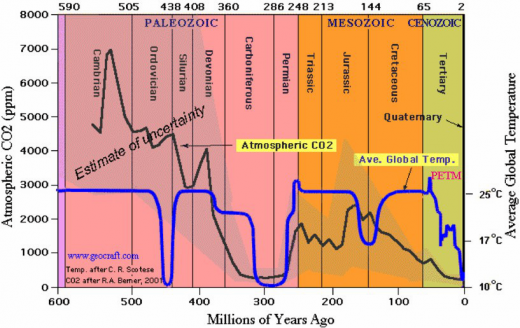
Berner skriver:

Richard Alley - 4.6 Billion Years of Earth’s Climate History: The Role of CO2:
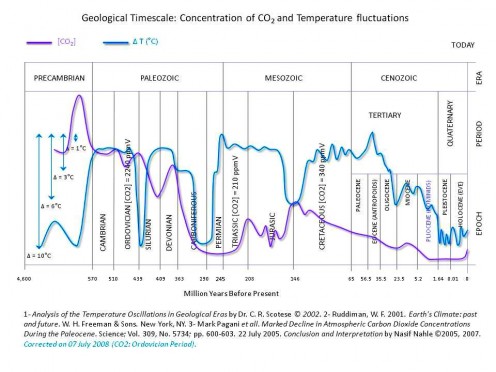
Bathymetric and isotopic evidence for a short-lived Late Ordovician Glaciation in a Greenhouse Period
https://stephenschneider.stanford.edu/Publications/PDF_Papers/CrowleyBaum1995.pdf
A weathering hypothesis for glaciation at high atmospheric pCO2 during the Late Ordovician
Long-lived glaciation in the Late Ordovician? Isotopic and sequence-stratigraphic evidence from western Laurentia
"In fact out of all the temperature datasets — land, sea, weather balloons, and two from satellites (UAH and RSS) — only one dataset had shown unexpectedly slow warming in recent years, the RSS data. Unsurprisingly, that is the dataset deniers like Ted Cruz have glommed on to — despite the fact that it was widely believed the RSS data was being misanlayzed."

Several groups of scientists began looking closely at this discrepancy. With so many other pieces of evidence indicating warming, it seemed unlikely that the troposphere would not be warming. Errors were discovered in the methods the UAH group used to adjust the data.
To understand what was wrong: The satellites must pass over the same spot on Earth at the same time each day to get a temperature average. In reality the time the satellite passes drifts slightly as the orbit slowly decays. To compensate for this and other orbital changes a series of adjustments must be applied to the data.
So rather than, say, providing the public the best science, Spencer sees his “job” as persuading the public not to support efforts to reduce carbon pollution. So it’s no surprise that Spencer chose such a misleading headline, despite the fact that his own chart’s running 13-month average clearly shows that temperatures are rising.
Denne studien oppklarer alt. Sensitivity of Satellite-Derived Tropospheric Temperature Trends to the Diurnal Cycle Adjustment
Grafen viser helt klart oppvarming. Fornekterne har ennå ikke skjønt det. La oss se på grafen en gang til:

Nå, la oss se på noen flere av de håpløse grafene som klimafornektere har resirkulert i årevis, inkludert denne John Christys “berømte” løgnaktige graf:Rasmus Benestad, D.Phil. Seniorforsker ved Meteorologisk institutt og leder for Tekna Klima, oppklarer Bergsmarks følelser om grafen -og John Christys feiltolkninger her.
– Dette er figuren som viser klimaskeptikerens manglende fagforståelse



BONUS:
THE UPDATED CORRECT COMPARISONS:
Comparing CMIP5 & observations

Roy Spencer's latest deceit and deception.
___________________________________________________

The next graph is also a deniers favorite. Its a trick they use all the time; Take a local / regional graph and make it represent global temp records.
Dr. Bye, Prof. Humlum, and Dr. Stordahl (BHS) rely on the GISP2 database to draw their graph.
Unfortunately, GISP2 is concerned with local temperatures on Greenland which do not accurately represent the average global temperature – nor even the Northern Hemisphere. Drawing conclusions on the global climate based on GISP2 amounts to pretending that the whole world is affected by heavy rainfalls based on the precipitations in Bergen [a Norwegian city known for plentifull rainfall]. And worse:
The graph stops in 1855, long before the GW we have seen over the last 130 years.
the GISP2 “present” follows a common paleoclimate convention and is actually 1950. The first data point in the file is at 95 years BP. This would make 95 years BP 1855 — a full 155 years ago, long before any other global temperature record shows any modern warming.
In order to make absolutely sure of my dates, I emailed Richard Alley, and he confirmed that the GISP2 “present” is 1950, and that the most recent temperature in the GISP2 series is therefore 1855.
Confusing Greenland warming vs global warming
The man behind the graph, Dr. Richard Alley is debunking the deniers misrepresenting his work:
“no single temperature record from anywhere can prove or disprove global warming, because the temperature is a local record, and one site is not the whole world.”
Reality Check on Old Ice, Climate and CO2
Grafen bruker altså temperatur-data fra toppen av Grønlands-isen. Data som er fra 1855!, (The reason is straightforward enough — it takes decades for snow to consolidate into ice.) lenge før moderne global oppvarming begynte pga menneskers C02-utslipp, og som attpåtil kun gjenspeiler regional lufttemperatur og har ingen verdens ting med GLOBAL oppvarming å gjøre.
For ordens skyld:
What has happened to temperatures at the top of Greenland ice sheet since 1855? Jason Box is one of the most prominent scientists working on Greenland and he has a recent paper reconstructing Greenland temperatures for the period 1840-2007 (Box, Jason E., Lei Yang, David H. Bromwich, Le-Sheng Bai, 2009: Greenland Ice Sheet Surface Air Temperature Variability: 1840–2007. J. Climate, 22, 4029–4049. doi: 10.1175/2009JCLI2816.1). He was kind enough to supply me with a temperature reconstruction for the GRIP drilling site — 28 km from GISP2. This is what the annual average temperature record looks like (click for bigger version):
English version:
“no single temperature record from anywhere can prove or disprove global warming, because the temperature is a local record, and one site is not the whole world.”[…] An isotopic record from one site is not purely a temperature record at that site, so care is required to interpret the signal and not the noise. An extensive scientific literature exists on this topic, and I believe we are pretty good in the community at properly qualifying our statements to accord with the underlying scientific literature; the blogospheric misuses of the GISP2 isotopic data that I have seen are not doing so, and are making errors of interpretation as a result.
____________________
Og bare for å gjøre et lite eksperiment. Du husker hva som var den mest sjuke, mest konspira, uvitenskapelige bloggen på internet? OK, NaturalNews, la oss sjekke der.....du mener ikke i ramme alvor at grafen finnes der.....? Sammen med den kreasjonistgrafen vi lo av nettopp?


Researchers from Remote Sensing Systems (RSS), based in California, have released a substantially revised version of their lower tropospheric temperature record.
After correcting for problems caused by the decaying orbit of satellites, as well as other factors, they have produced a new record showing 36% faster warming since 1979 and nearly 140% faster (i.e. 2.4 times larger) warming since 1998. This is in comparison to the previous version 3 of the lower tropospheric temperature (TLT) data published in 2009.
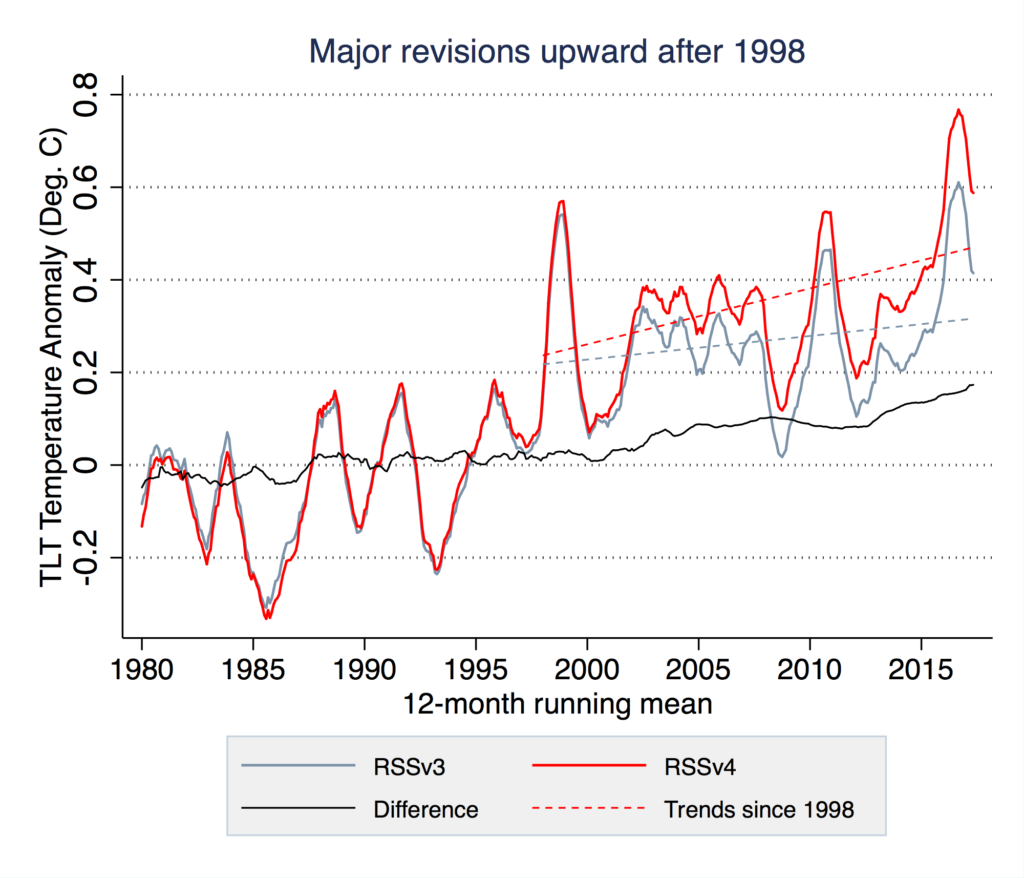
Here we see how deniers make their fake graphs:

into this:

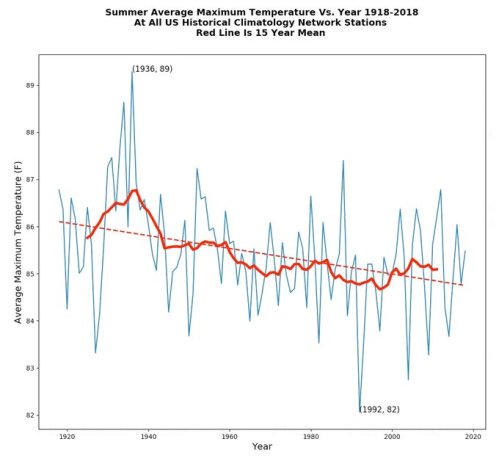
Deniers are kicking in open doors because;
Everything is available on their web pages and in the peer reviewed literature.
And there is conciliense and convergence science at work here. NOAAs data is confirmed by oceans data and satellite data which also shows the same warming trend.INCLUDING the UAH satellite data from Roy Spencer and John Christy which deniers always have referred to as "the most reliable" data.
How is the average global temperature anomaly time-series calculated?
Why do some of the products use different reference periods?
The national maps show temperature anomalies relative to the 1981–2010 base period. This period is used in order to comply with a recommended World Meteorological Organization (WMO) Policy, which suggests using the latest decade for the 30-year average. For the global-scale averages (global land and ocean, land-only, ocean-only, and hemispheric time series), the reference period is adjusted to the 20th Century average for conceptual simplicity (the period is more familiar to more people, and establishes a longer-term average). The adjustment does not change the shape of the time series or affect the trends within it.
Studien dette er hentet fra er / Here is the study graph is taken from:
Spatial and temporal patterns of global burned areain response to anthropogenic and environmentalfactors: Reconstructing global fire historyfor the 20th and early 21st centuries
Yang, J., H. Tian, B. Tao, W. Ren, J. Kush, Y. Liu, and Y. Wang (2014), Spatial and temporal patterns of global burned area in response to anthropogenic and environmental factors: Reconstructing global fire history for the 20th and early 21st centuries, J. Geophys. Res. Biogeosci., 119, 249–263, doi:10.1002/2013JG002532.
But what are the conclusions from the study? Are they the same as the claim, "seems like an inverse relationship to me"? Notice the C02 line added to the graph, which misrepresent what the study set out to do. And no, the study does not support the claim.
Global burned area going down is primarily because of human activities, which the study clearly tells; Its about deforestation, increased crop lands and population increase.

"In our study, human impact was identified as the primary factor accounting for the declining trend in global fire activity, which reduced global burned area"
In the tropics, cropland area increased by 76.6%, and population increased by 310% from the 1900s to 2000s
Thus the graph is not proof against AGW. The study actually concludes with the opposite:
"The impact of climate change in extratropics is becoming increasingly important and may induce more fires in the context of global warming".

This is not an accurate comparison, according to Randy Eardley, a spokesman at the NIFC. As he tells Carbon Brief:
Burning history - fiery furphies.
This post is about some exaggerated accounts that circulate about past forest fires. The exaggeration had been part of a normal human tendency - no-one cares very much whether accounts of events that caused suffering inthe past may be inflated, and so the more dramatic stories win out. But then maybe it does begin to matter.
The organisation currently responsible for presenting US fire history statistics is the National Interagency Fire Center. And their equivalent table lists data back to 1960, which pretty much agrees where it overlaps with the old census data to 1970. But they rather pointedly go back no further. And at the bottom of the table, they say (my bold):
"Prior to 1983, sources of these figures are not known, or cannot be confirmed, and were not derived from the current situation reporting process. As a result the figures above prior to 1983 shouldn't be compared to later data."
Again we see deniers misusing facts to suit their narrative.


Even if the number were correct:
Also the US Forest Service are saying the opposite of what deniers claim:
Do you think the drop in burned forest areas in the US had anything to do with the US Forest Service was established in 1905?
With a more advanced fire fighting department?
With the Fire Management Today Forum created in 1936 to further inform the public on fire prevention matters?
Any drop was not related to GW not happening.
US Forest Service
- More frequent wildfires that burn larger areas
- More severe problems with insects, pests, and diseases threatening trees and crops
- Snowpack decline in mountainous regions due to decreased snowfall and shorter winters
- Plant and animal ranges shifting northward to accommodate warmer temperatures
- Threatened watersheds due to more frequent water shortages, increased pest and fire severity, and shifts in ecosystem health
https://waa.ai/alEc
Why?
Because warmer temperatures increase evaporation, which means the atmosphere draws more moisture from soils, making the land drier.
A warmer climate also leads to earlier snowmelt, which causes soils to be drier for longer. And dry soils become more susceptible to fire.
"The areas where wildfires are taking place are always areas that [have become] drier and hotter, and where spring has come earlier," said Funk.
Drier conditions and higher temperatures increase not only the likelihood of a wildfire to occur, but also the duration and the severity of the wildfire. Wildfires are typically either started accidentally by humans - such as a burning cigarette carelessly tossed out of a window - or by natural causes like lightning.
What the peer reviewed science say on forest burned areas:
"For all ecoregions combined, the number of large fires increased at a rate of seven fires per year, while total fire area increased at a rate of 355 km2 per year. Continuing changes in climate, invasive species, and consequences of past fire management, added to the impacts of larger, more frequent fires, will drive further disruptions to fire regimes of the western U.S. and other fire-prone regions of the world."
Large wildfire trends in the western United States, 1984–2011
GRL
DOI: 10.1002/2014GL059576
https://agupubs.onlinelibrary.wiley.com/doi/abs/10.1002/2014GL059576
And
"We show that fire weather seasons have lengthened across 29.6 million km2 (25.3%) of the Earth’s vegetated surface, resulting in an 18.7% increase in global mean fire weather season length. We also show a doubling (108.1% increase) of global burnable area affected by long fire weather seasons (>1.0 σ above the historical mean) and an increased global frequency of long fire weather seasons across 62.4 million km2 (53.4%) during the second half of the study period."
Climate-induced variations in global wildfire danger from 1979 to 2013
NATURE
doi:10.1038/ncomms8537
https://www.nature.com/articles/ncomms8537
"Anthropogenic increases in temperature and vapor pressure deficit significantly enhanced fuel aridity across western US forests over the past several decades and, during 2000–2015, contributed to 75% more forested area experiencing high (>1 σ) fire-season fuel aridity and an average of nine additional days per year of high fire potential.
Anthropogenic climate change accounted for ∼55% of observed increases in fuel aridity from 1979 to 2015 across western US forests, highlighting both anthropogenic climate change and natural climate variability as important contributors to increased wildfire potential in recent decades.
We estimate that human-caused climate change contributed to an additional 4.2 million ha of forest fire area during 1984–2015, nearly doubling the forest fire area expected in its absence.
Natural climate variability will continue to alternate between modulating and compounding anthropogenic increases in fuel aridity, but anthropogenic climate change has emerged as a driver of increased forest fire activity and should continue to do so while fuels are not limiting."
Abatzoglou and Williams 2016 - Impact of anthropogenic climate change on wildfire across western US forests
PNAS
doi: 10.1073/pnas.1607171113"
http://www.pnas.org/content/113/42/11770
______________________________________________
Extreme weather left its mark across the planet in 2016, the hottest year in recorded history. Record heat baked Asia and the Arctic. Droughts gripped Brazil and southern Africa. The Great Barrier Reef suffered its worst bleaching event in memory, killing large swaths of coral.
Now climate scientists are starting to tease out which of last year’s calamities can, and can’t, be linked to global warming.
https://www.nytimes.com/2017/12/14/climate/climate-extreme-weather-attribution.html?smid=fb-share
KLIMAENDRINGENE ØKER IKKE KOSTNADENE MED EKSTREMVÆR ?

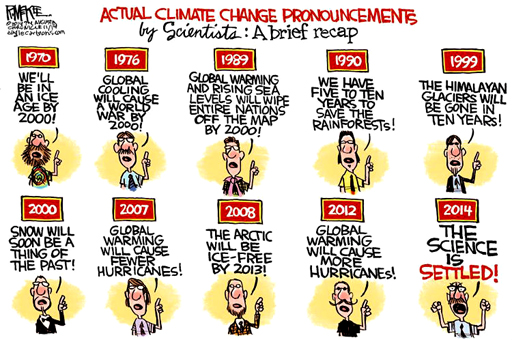
Debunk:
https://skeptic78240.wordpress.com/2016/04/08/the-comical-conservative-6/?fbclid=IwAR1kN5n3ALxBtqa5vIkyy5HQ8TKEkXqQg1wusnxllc37iiq196Obsm4LKvQ
Dr David Viner at CRU, England, never said that "Snowfalls are now just a thing of the past.". That was the headline the newspaper choose for their article, making it more sensational but losing the plot.
Dr Viner was also quoted as saying: "We're really going to get caught out. Snow will probably cause chaos in 20 years time."
The headline in this case is not what the story itself said, as Dr Viner made clear. The story was about the frequency of snowfalls, and how "snow is starting to disappear from our lives", which it stated clearly.
So a headline saying that "snowfalls are now just a thing of the past" is not a scientific prediction or statement. It is a newspaper headline, and should be treated as an invitation to read the entire story, which in this case clearly pointed out that snowfalls are becoming less frequent in Britain.
https://www.independent.co.uk/news/science/steve-connor-dont-believe-the-hype-over-climate-headlines-2180195.html
https://tinyurl.com/yy4eglrz
Anyway. Climate science dont make predictions based on a newspaper interview with one (1) scientist. Its the combined knowledge from thousands of scientists world wide. Look for the predictions in the peer reviewed science and the peer reviewed reports.
Like this one out from the USA in the autumn of 2017 which was peer reviewed by the National Academy of Sciences, the worlds most respected scientific academy, founded by Abraham Lincoln and with 200 Nobel Prize winners as members.
https://science2017.globalchange.gov/
For regions that are less than 1000m above sea level and that currently experience winter temperatures just below freezing, he found that the chance of an extreme snowfall event will drop by an average of just 8%. But the total amount of snow that falls in these areas each winter may drop by as much as 65%, on average.
http://www.bbc.com/earth/story/20160127-will-snow-become-a-thing-of-the-past-as-the-climate-warms
DEBUNK 2:
'Snowfalls are now just a thing of the past'
When the Earth comes out of an ice age, the warming is not initiated by CO2 but by changes in the Earth's orbit. The warming causes the oceans to release CO2. The CO2 amplifies the warming and mixes through the atmosphere, spreading warming throughout the planet. So CO2 causes warming AND rising temperature causes CO2 rise. Overall, about 90% of the global warming occurs after the CO2 increase.
The reason has to do with the fact that the warmings take about 5000 years to be complete. The lag is only 800 years. All that the lag shows is that CO2 did not cause the first 800 years of warming, out of the 5000 year trend. “The sequence of events during this Termination is fully consistent with CO2 participating in the latter 4200 years of the warm-”
What does the lag of CO2 behind temperature in ice cores tell us about global warming?
Roger Fjellstad Olsen's answer to What lags, C02 or temperature? Have you heard of the correct "It's both" alternative?
https://skepticalscience.com/col...
Try using a graph which includes modern warming.
Here we see the moment when natural climate change became AGW! The moment climate was forced out of its Natural Milankovitch cycle to head in the opposite direction:
Roger Fjellstad Olsen's answer to What are the causes of climate change







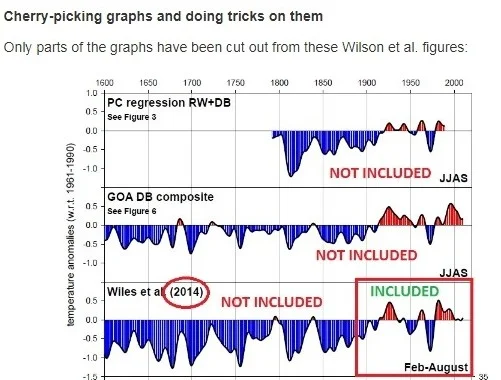

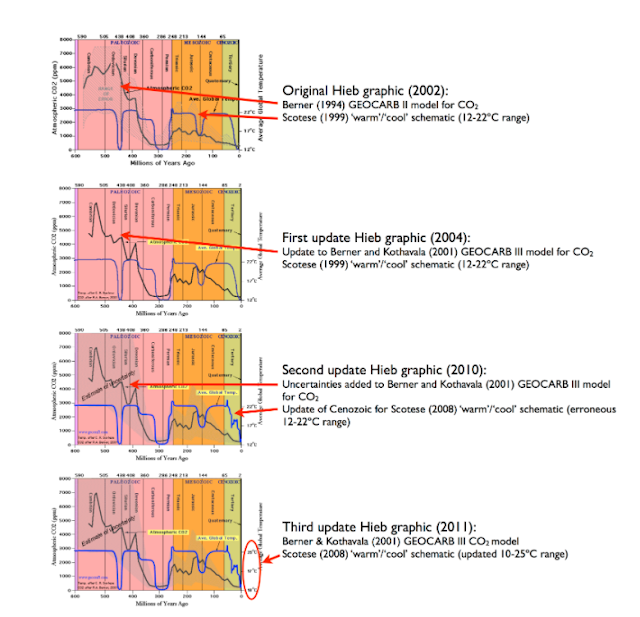








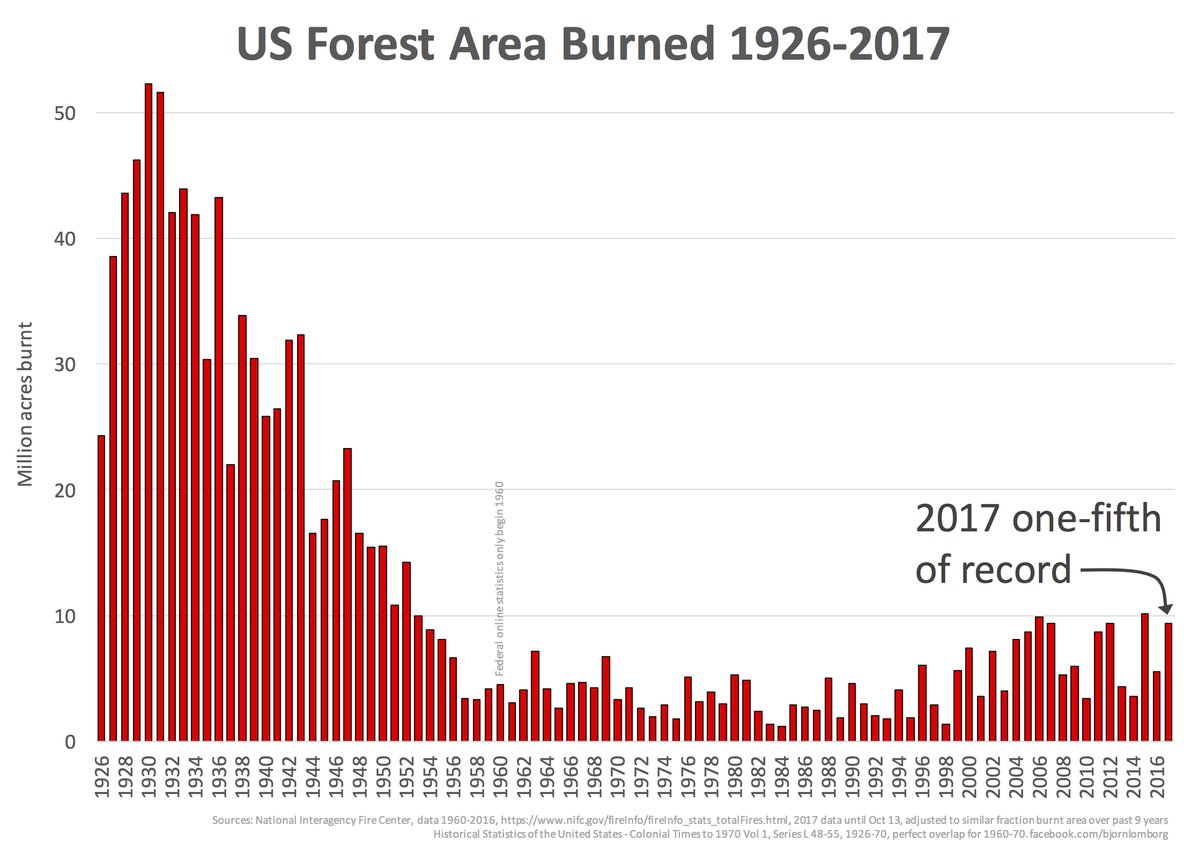



Ingen kommentarer:
Legg inn en kommentar